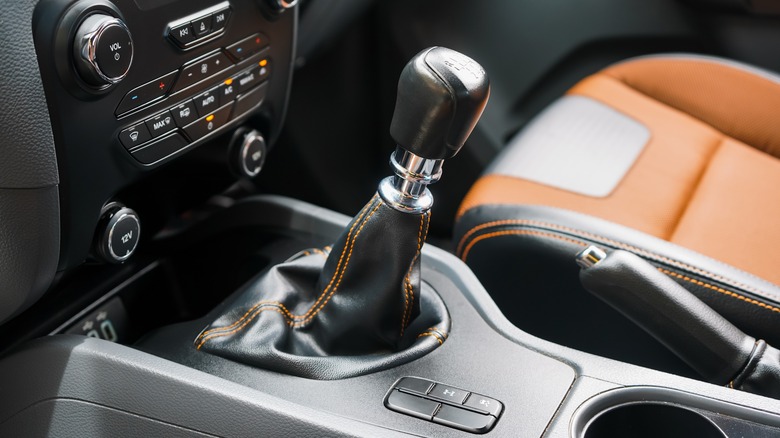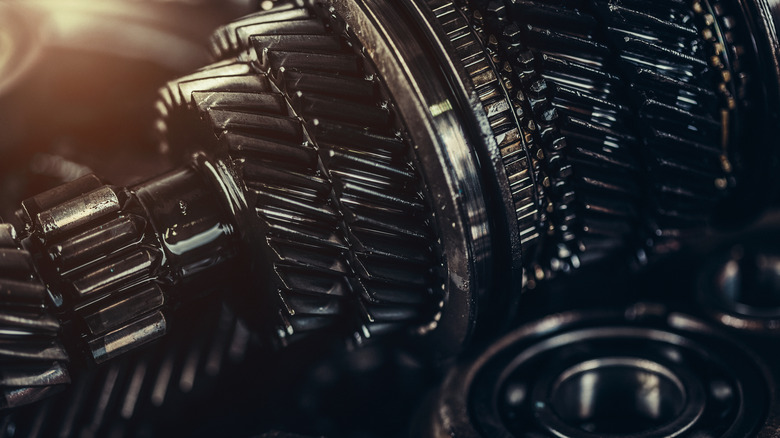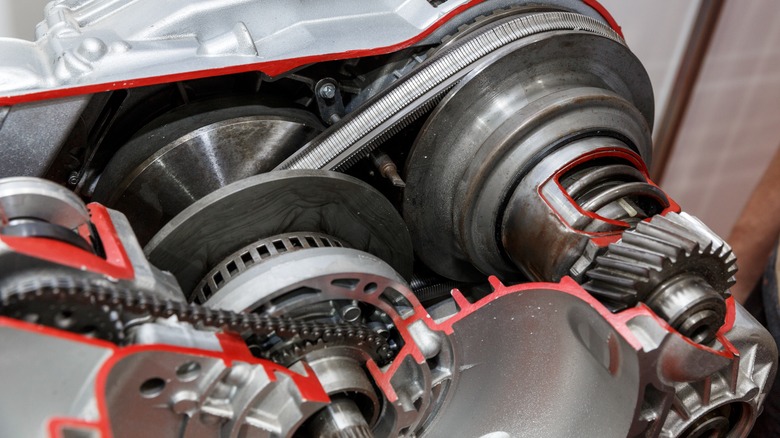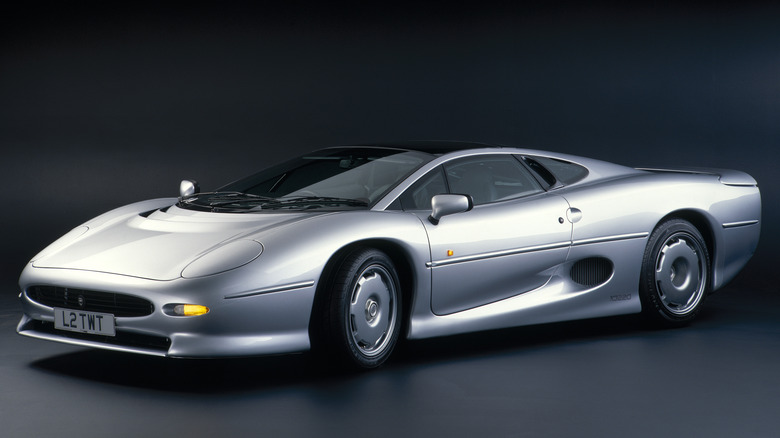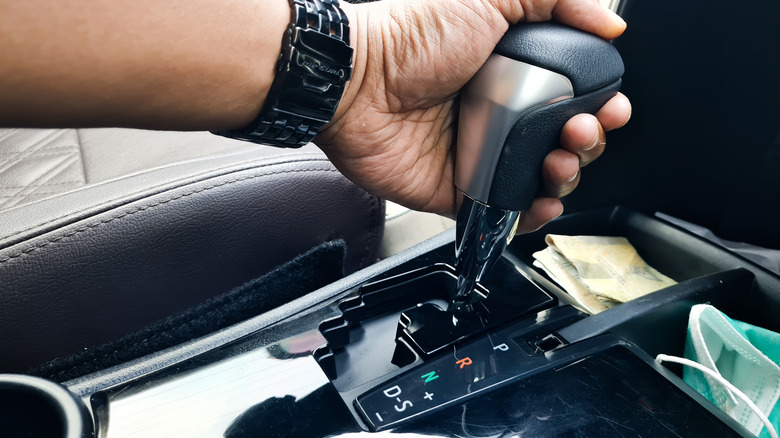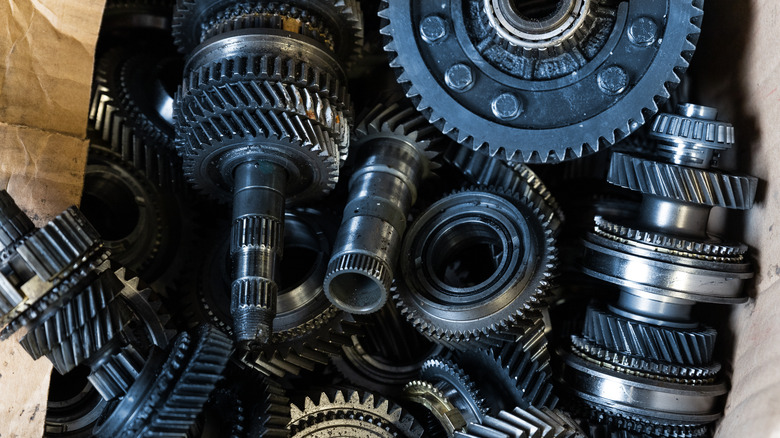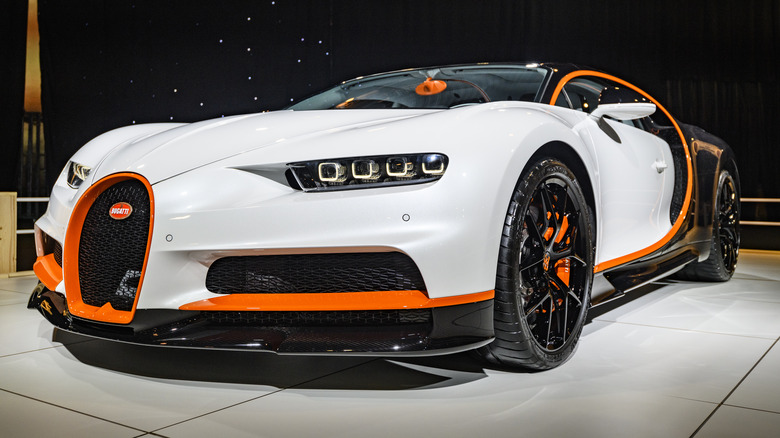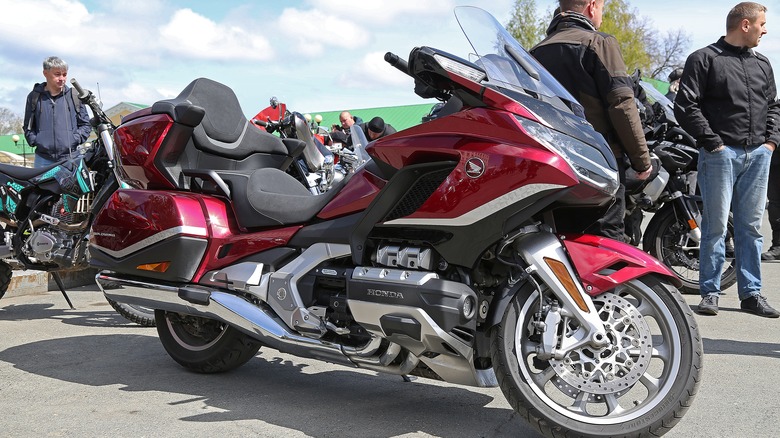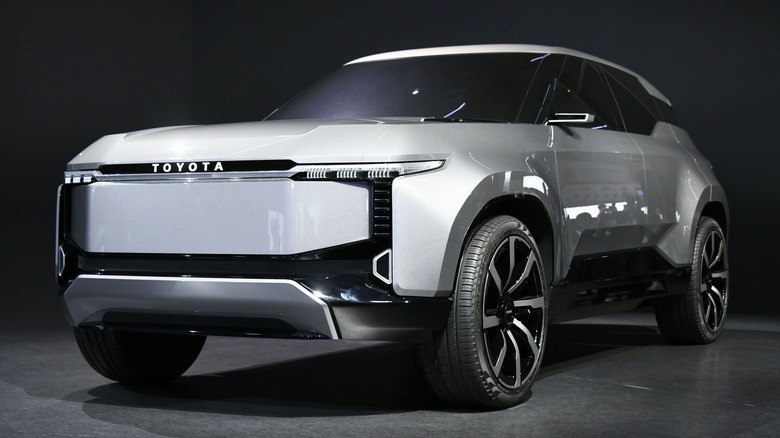Manual Vs. Automatic: Which Transmission Is Better?
Modern drivers are faced with several options when deciding upon their ideal vehicle. These include gas or electric power, its drivetrain — be it a front-wheel drive, rear-wheel drive, or four-wheel drive solution — alongside a multitude of features, accessories, and options right down to the color of its paint. However, one of the fundamental decisions you will make while shopping for a car is its transmission type.
The transmission is one of the most complex components in a car as it controls the amount of power transferred to the wheels. Simply put, an automatic transmission does the shifting for you, whereas a manual transmission requires you to select the optimal gear. So, while an automatic vehicle offers the ultimate drive assist technology — short of self-driving automation — driving a stick shift requires a separate skillset to keep your car in motion. This can be seen as either superfluous or beneficial, depending on how and where you use your vehicle.
The ultimate question of shifting versus not shifting depends on personal preferences and a range of lifestyle and practical considerations. Whether you chiefly use your car for work, drive for pleasure, or simply see it as a utilitarian vehicle that ferries you from A to B, your choice of transmission type affects the entire driving experience. Here, we take a closer look at the benefits and drawbacks of each option to see how they measure up.
What is a manual transmission?
A manual transmission, also called a stick shift or simply a manual, is a means of manually selecting the gear ratio to control the way that the engine's power is transferred to the driveshaft. This allows for a smoother interaction between the engine and the wheels — assuming the operator is skilled with the manual transmission — and enables the driver to run the vehicle with maximum efficiency in power delivery and fuel economy.
Depending on the vehicle, there will be a number of gear ratios to choose from, plus neutral (stationary) and reverse gear. First gear offers the most pulling power, whereas the highest gear has the most potential for speed. As your engine increases speed, you must shift up through the gears to suit the change in RPM (revolutions per minute). The lower the gear, the more power and control you have over your vehicle when pulling away or ascending and descending a steep hill, for example. A manual driver must use their judgment to optimize their gears for speed and road conditions.
When changing gears using a manual transmission, a clutch pedal must be depressed to disengage power to the wheels. The clutch works by pressing together or releasing two or more spinning discs that connect the transmission to the driveshaft using the pressure provided by strong springs. After the gear is selected, you release the clutch pedal, and you can then gradually reapply power to the wheels via the accelerator pedal.
What is an automatic transmission?
While the process of driving a manual car may sound complicated, many drivers find that it becomes second nature with practice. However, it is one more thing to think about while driving, and the easier option is to drive a car with an automatic transmission. Often simply referred to as automatics, vehicles with an automatic transmission select the optimal gear ratio for you based on the vehicle's speed, engine load, and other factors. As such, they do not require a clutch pedal.
The automatic transmission is a marvel of modern engineering that relies on a Transmission Control Module, or TCM, to do the thinking for you. It uses valve technology to control a series of brakes and clutches to change gear. There are more components in an automatic transmission than a manual, including planetary gears, multiple clutches, brakes, a hydraulic pump, hydraulic fluid, and a torque converter. The torque converter is used in place of a clutch, and a complex hydraulic system engages and disengages gears. The TCM selects the best gear ratio based on your speed and driving conditions or even shifts down for you when you apply gas to accelerate, for instance, when overtaking.
Unlike with a manual transmission, a basic understanding of an automatic gearbox's mechanics is not essential to operate the vehicle, which usually has four basic driving modes. These are Drive, Neutral, Reverse, and Park, the latter to be used in conjunction with your handbrake.
Pros of manual cars
Those who regularly drive a manual car often suggest they experience a better connection with the road. Indeed, using a manual gearbox is much more hands-on and provides a more immersive driving experience, as you are required to work with the vehicle to keep it operating at its best. You also have better control over the way your car behaves, especially when it comes to slowing down.
Progressive downshifting through the gears provides controlled engine braking that allows you to regulate your speed without losing traction. Conversely, a manual gearbox can assist in acceleration, as you can shift more quickly when your engine reaches the optimal revolutions using your tachometer for reference. For this reason, manual gearboxes are more commonly found in high-performance cars and competition vehicles.
As a manual gearbox is less mechanically complex, it can cost less to maintain. Manual transmissions are traditionally considered more fuel-efficient than their automatic counterparts due to the power loss associated with an automatic's torque converter, although more modern automatic transmissions have begun to reverse this trend. It should be noted, however, that both of these points only apply with proper use, as a burned-out clutch or ill-timed shifting could have the opposite effect on maintenance and running costs.
Cons of manual cars
The hands-on nature of a manual transmission can have its drawbacks. They can be less safe as concentration is divided between steering, accelerating, braking, and shifting, and the driver's left foot has to synchronize with your shifting hand. This could infringe on your ability to make split-second decisions while creating mental fatigue over time.
There is also the issue of physical fatigue that arises from constantly depressing the clutch pedal on long-haul trips. This is never more apparent than when in heavy traffic, as you must repeatedly stop and start your vehicle and must continually balance the clutch and gas pedals as you edge slowly forward. This can become particularly taxing if your vehicle has a particularly heavy clutch or a lot of travel in your clutch pedal.
While it is true that manual shifting becomes second nature over time, you can often be caught out, and stalling a manual vehicle is not uncommon. There is also the possibility of a muddled gear change, followed by an unsophisticated crunch, which is both concerning and embarrassing for those in the driving seat.
Pros of automatic cars
If driving is a practical pursuit, as a simple means of conveying you to your destination, then an automatic transmission is likely the best option for you. The fact that a transmission is so complex makes it something that many road users would rather not have to think about.
As such, the main benefit of an automatic car is obvious — they are far easier to drive than their manual counterpart, and this has a positive effect on driver fatigue, concentration, and awareness. Stopping and starting in traffic is a breeze, leaving the driver blissfully unaware of most of the decisions being made on the part of the transmission.
Automatic cars also provide a smoother driving experience due to the seamless action of their hydraulic shifting mechanism, as compared to the often jerkier nature of a manual clutch. This is a benefit shared by both drivers and passengers, as it translates to better well-being, especially when traveling over long distances.
There are also instances when an automatic transmission is especially helpful. These include hill starts when you are far more likely to stall a manual car and risk rolling backward or when performing complex maneuvers, as you don't have to focus on shifting. They are also helpful when towing, as they better regulate the heavy load, whereas, with a manual gearbox you run the risk of damaging your clutch.
Cons of automatic cars
While enthusiasts may consider an automatic car less exciting to drive, that is both subjective and unimportant when considering a vehicle's primary purpose is to get you to your destination safely and efficiently. However, there are a couple of drawbacks that should be noted, especially if you are on the fence between buying a manual or an automatic.
One consideration is that automatic vehicles often have a shorter lifespan than their manual counterparts due to the complexity of their transmission. This complexity also means that maintenance is more frequent and costly than on a manual vehicle, barring notoriously expensive clutch replacements.
It should also be noted that automatic cars are generally more expensive than their manual equivalent, both when buying new and in used markets. This is because, once again, their added complexity demands higher production costs. So, as with many things in life, you must pay for added convenience where automation is involved.
Variations on the automatic gearbox
While the torque converter option is one of the most commonly used automatic gearboxes in the modern automotive industry, there are other types of automatic gearboxes to suit various budgets and vehicle segments.
For example, some more affordable car models use an automated manual gearbox. These use similar mechanics to a regular manual transmission, but electric motors assist in shifting between gears in place of a conventional clutch, which speeds up the process, making them an economical choice.
Alternatively, a CVT, or continuously variable transmission, uses a system of belts and cones in place of gears. The belts constantly travel up and down the cones to select the most efficient gear ratio. This is a smooth and economical option that is popular in many Japanese brands.
Another option is a DCT or dual-clutch transmission. This is similar to the automatic manual gearbox in that it is essentially a manual gearbox with an electronic control unit that shifts gears. However, as it has two clutches, it is a more efficient system as one clutch controls the currently selected gear while the other anticipates the following gear change, making shifting quicker.
Automatic and manual transmission myths debunked
While the differences between manual and automatic gearboxes are well-documented, there remain some common beliefs about both that have either become less relevant with evolving technologies or were never accurate in the first place.
For example, while it may be true that those who seek high performance favor a straightforward manual transmission, many sportscar manufacturers install advanced manual transmissions in their creations. With the introduction of semi-automatic paddle shifters, drivers are treated to clutchless shifting while retaining control over the transmission. As automatic transmissions continue to be refined, we will doubtless see a growing trend for automatic sportscars, especially as the lucrative American market overwhelmingly favors this option.
It is often said that manual transmission is more fuel-efficient, and that was indeed once the case. Still, with the introduction of electronically-assisted systems, including DCT, the lines are becoming blurry between manual and automatic transmissions' performance. As renewable energy becomes more mainstream, this may become obsolete in the near future, as most electric vehicles use no transmission.
Another popular misconception is that manual cars perform better in adverse conditions. Again, this was once the case that when driving on poorly paved surfaces or ice and snow, manual control was favorable over its automated counterpart. However, with later developments in automatic transmission technology, coupled with improved tire technology and modern driver assists, such as traction control, contemporary automatic gearboxes are more than capable of dealing with difficult driving conditions.
Automatic and manual transmissions on motorcycles
When it comes to motorcycles, your transmission is even more fundamental, not only to the riding experience but also to how your vehicle interacts with the road, rider safety, and performance. Here, the effects of the transmission are intensified, as shifting in either direction has a significant impact on the motorcycle's speed and must be used in conjunction with the throttle and brakes to regulate the motorcycle's performance.
While riding a motorcycle, it is essential that you never lose traction, barring some controlled maneuvers when off-roading. As such, engine braking is all the more important to reduce speed while keeping the wheels moving and helping to avoid lockups. While this can certainly happen if you downshift too quickly, controlled engine braking is always safest, provided you have the necessary time and space available.
For this reason, most motorcycles have manual transmissions, but there is an emerging market for large-capacity motorcycles with automatic transmissions. Some of these have met great acclaim, not the least of which is Honda's celebrated DCT technology that is included as an option on its Gold Wing, Africa Twin, NC750X, and Rebel models.
As automotive technology adapts to renewable energy, there is also an emerging market for electric motorcycles, which do not have a traditional transmission. This leaves motorcyclists with a question as to the future of life on two wheels — will they have to adapt their riding to meet new technologies, or will the technology adapt to them?
Which is right for you?
There is a simple distinction between cars with manual and automatic transmissions. A manual is simpler in its construction but more challenging to operate, whereas an automatic is more mechanically complex and is easier to operate. Whether you opt for simplicity of design or simplicity of operation is a personal choice, and it can depend on many contributing factors. It is difficult to sell the benefits of an automatic to someone who enjoys the immersive driving experience provided by manually shifting gears, just as it's hard to sell the extra work involved in driving a stick to those who were raised on the convenience of an automatic.
There is also the cultural factor, as specific markets favor one or the other. In Europe, around 80% of all car sales have a manual transmission, compared to under 2% in the USA. Many factors contributed to this, such as how the road systems were structured on each continent and a culture that traditionally favored fuel economy and ease of repair compared to one that preferred convenience and ease of use. Traditions stick from one generation to the next, and the market still reflects this. However, trends are set to change considerably as electric vehicles continue to gather momentum globally.
Your choice of transmission is as personal a choice as the color of your vehicle's upholstery. Where previous generations of automatic transmissions had their pitfalls as compared to the relative simplicity of a manual gearbox, modern technology has caught up. Now, this evolution has leveled the field, making the argument for manual versus automatic transmissions a more significant gray area than ever before.
